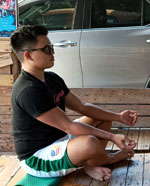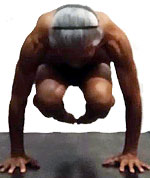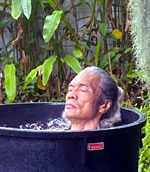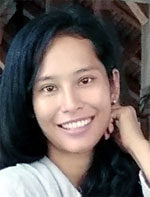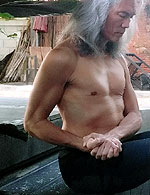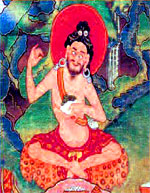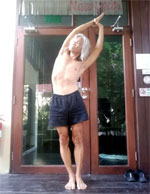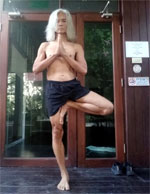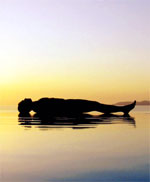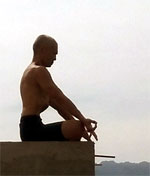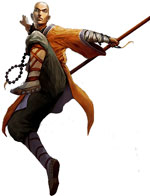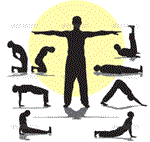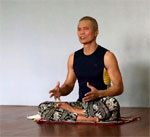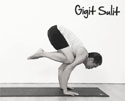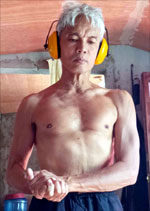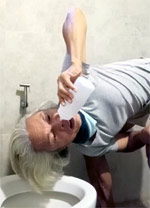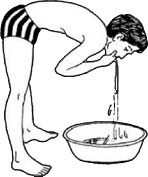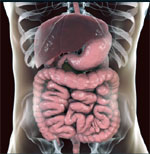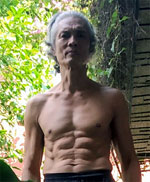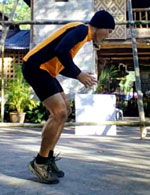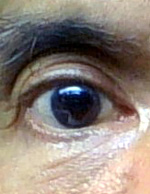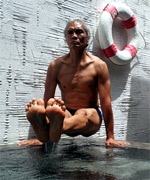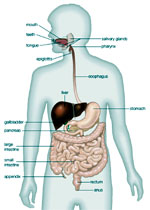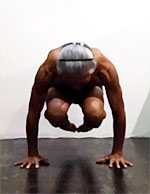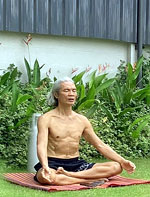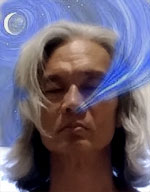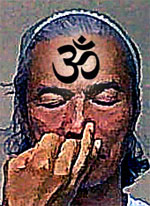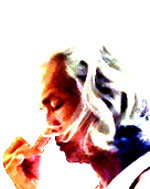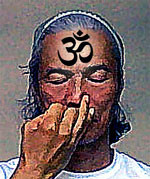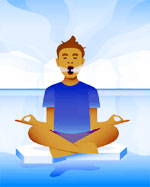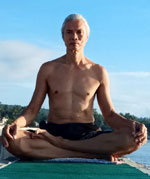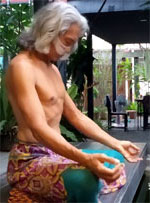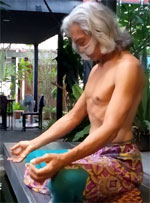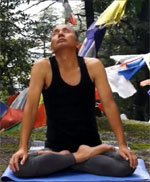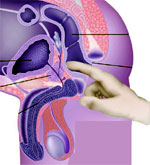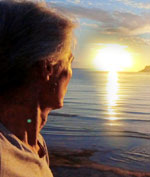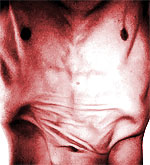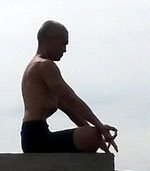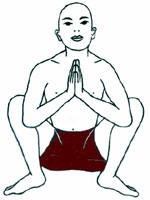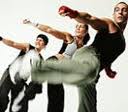

Studio-type Yoga classes
Studio-Type Yoga Series
Yoga classes typically offered in Yoga Studios
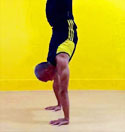 Aug 23, 2015
Aug 23, 2015
Handstand Clinic at Surya Nanda Yoga Studio
A detailed pose-by-pose articulation of a 2-hour handstand workshop
(updated Sep 17, 2021 for a class in Chiang Mai, Thailand)
Class Locations ![]() :
:
Cebu City, Philippines
Chiang Mai, Thailand
Subbing for Mechele and Steve
I'd been a regular participant in Mechele and Steve's Sunday Handstand Clinic - it's a great community and this dynamic duo are simply FAB. I got a message from the studio asking me if I can substitute for this Sunday as they can't make it. Hmmmm. Handstand has long eluded me despite my marginal gains. This offers me the opportunity to research and develop a sequence that may unlock some hidden secret...and of course, share with the class.
Disclaimer
Let's get this clear at the outset - I'm NOT packaging myself as the Handstand Master. There are yogis in Cebu who deserve that title - not me. I've long been practising on my handstand for years now. I can put myself vertically on a handstand with considerable ease - but I can't hold my handstand into a steady state for more than 15 seconds. Not yet. Only when I can hold it steady for a full minute (min) can I consider it a handstand. I know the techniques enough to teach it, but just like anything else, it boils down to practise...practise...and more practise.
The techniques listed here are by no means the definitive be-all and end-all to a successful handstand. Every successful handstander (for lack of a better word), will probably have his/her own developed technique. But give this technique a fair chance as it has proven to be of benefit to many subscribers.
Managing Expectation
Let's manage your expectation first - you won't be able to do a handstand just by attending this clinic. But you'll get the big picture on how to proceed with the practice. Handstand is a difficult asana that takes years to develop. It demands strength, balance, focus, stamina and requires full-body coordination from the top of the head to the feet. But just like everything else, with persistent practice, you will at one point nail the handstand.
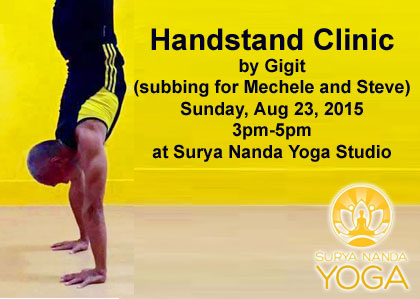
Dependencies
To perform a good handstand, most people think it's just a matter of balance. Yes, but there's more to it:
- balance - yes, let's put this first as it's the most obvious and most self-explanatory
- strength - there are many muscles needed to support you in getting into and holding a handstand - and they all need to be strong. The weakest link will cause the handstand to fail. The core needs to be developed as it carries a lot of load on a handstand, especially when engaging in bandhas. Shoulder muscles carry a lot of weight as well and they need to be strong.
- flexibility - on a handstand, the should is perhaps the lynchpin (central cohesive source of stability and security). If the shoulder is not open enough, an angle is created and the wrist, shoulders and hips cannot be vertically stacked
- technique - yes, it's not just balance, strength and flexibility. Technique is a big factor, and there are lots of techniques. There is no one-technique fits all. You have to experiment until you find one that suits you.
- coordination - all the muscles involved from the tips of the fingers to the tips of the toes need to function as a singularity - they have to talk to each other and coordinate with each other like many musical instruments in a symphony. All the individual body parts need to do their part in sustaining a handstand
- endurance / stamina - you may have the strength to go into a handstand. But how long can you hold it? Holding a handstand is far more difficult than holding a high plank.
- practice - it's so obvious, why am I even mentioning it? Unlike doing a high plank where you can nail it on the first attempt, a handstand, even if you have all the ingredients present, will not amount to anything until you devote a lot of time practicing. To underscore this point, Kino McGregor, the shining star of Ashtanga Yoga, admitted taking 5 years to master the handstand.
Given that, the asana warm-ups to this session will be focused on the core, shoulder openers, wrist conditioning and upper arm strength.
In your private yoga practice, give greater emphasis on doing Navasana (boat pose - front abdominal muscles), Vasisthasana (side plank - obliques), Salabhasana (locust pose for lower back muscles) and Chaturanga (push-up motion for shoulder power).
Benefits
- more blood flow to the perception Organs - it puts the perception organs (eyes, ears, tongue, nose, brain) below the heart and facilitates blood flow. It doesn't have to fight gravity
- restacking of the internal Organs - it displaces the internal organs upwards neutralizing the downward push of the diaphragm when breathing
- it builds strength - handstands do not only strengthen the shoulders and upper arms, but the entire body as well because it requires a full-body conditioning workout.
- focused mindfulness - even though a handstand looks static, the mind is intensely focused on holding the handstand and the entire body needs to be nimble and responsive from finger pressure, to abdominal bandhas, weight transfer, etc.
- body awareness - awareness of what your body is doing in space. This helps us in other sports and activities
- fun - handstands are the coolest!!!
- acceptance - learn to deal with what the body can and cannot do. You become more accepting

Class Instruction Begins Here
I WRIST CONDITIONING
The wrist has many moving parts and quite vulnerable when we subject it to bear weight, transfer weight and repetitive movement. Over time without proper support, an injury may happen. Also, on a handstand, the wrists bear the full body weight. Keep in mind that on an upright pose, two thick ankles support our body weight - now, we transfer that same load a pair of wrists half the size of ankles.
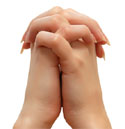 Interlaced Hands Rotation ()
Interlaced Hands Rotation ()Clasp your hands in front of your chest with elbows resting on the rib cage. Rotate your hands in a figure 8 motion (or infinity motion). Other side.
 Tabletop Roll with Hands Facing Forward ()
Tabletop Roll with Hands Facing Forward ()On Tabletop, with hands facing forward, try to move your body clockwise in a circular motion. Widen the circle as you progress. Back to center. Otherside.
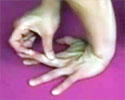 Finger Flexion ()
Finger Flexion ()On Tabletop, with hands facing forward, put your left hand on the center, and use your right hand to pull the individual fingers of the left hand while the upper palm is pressed against the mat. Otherside.
 Tabletop Roll with Fingers Facing Back ()
Tabletop Roll with Fingers Facing Back ()On Tabletop, with fingers facing back, try to move your body clockwise in a circular motion. Widen the circle as you progress. Back to center. Otherside.
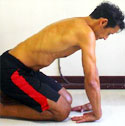 Tabletop SideRoll with Fingers Facing Back Palms Up ()
Tabletop SideRoll with Fingers Facing Back Palms Up ()On Tabletop, with fingers facing back and palms facing up, try to move your body back until you feel the wrist stretch and start moving your pelvis from left to right. Ensure that the arms are straight to isolate the stretch on the wrists.
II LIGHT WARM-UP STRETCH
 Child's Pose (Balasana)
Child's Pose (Balasana)Let's all find ourselves in Child's Pose, knees wide to accommodate the shoulders. Reach out forward with your fingers and sink the shoulders down keeping the arms straight, elbows straight. Feel the stretch on the shoulders. Inhale, lift an inch looking forward and reach out some more. Drop down deeper.
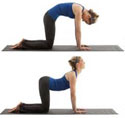 Cat and Cow Pose (Bitilasana | Marjaryasana)
Cat and Cow Pose (Bitilasana | Marjaryasana)Bring your body up on Table Top, shoulders above the wrist, hips above the knees. Inhale, sink the belly down, tailbone out, face slightly lifted. Exhale, round the back, tuck the tailbone in, neck remains neutral. Repeat.
 Downward Dog (Adho Mukha Svanasana)
Downward Dog (Adho Mukha Svanasana)Let's all find ourselves in Downward Dog, but be easy, we're starting cold here. Just acclimatize into the pose, pedal your heals up and down, bending the knees and moving the hips from side to side. Maybe the heels are still not touching the mat...that's ok. We'll sink slowly into the pose.
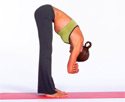 Relaxed Standing Forward Bend, Hanging
Relaxed Standing Forward Bend, Hanging Let's slowly walk our hands back towards our toes...and let's fold our arms into our elbows, upper body hingeing from the hips. Knees could be slightly bent and we simply do nothing for now...just allowing gravity to do its work. As we stay here, feel the back of the legs loosening up, feel the lower back muscles letting go. Breathe! still mindful of the Bandhas....pulling up the perineal muscle and engaging our abdominals 2 inches below our navel.
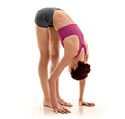 Hand Walking ()
Hand Walking ()Drop your hands onto the floor and begin to walk your hands to your left, twisting the body in the process. Where you reach your edge, stop, hold and breathe. Release the hands and do the other side.
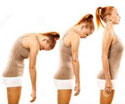 Spine Roll-Up
Spine Roll-Up release the arms and on one long inhale, with a rounded back, vertebrae by vertebrae, roll-up into standing (Samasthitihi)
III SHOULDER OPENERS
A flexible shoulder opens up to properly align the body into a handstand
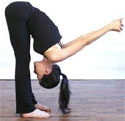 Forward Fold with Clasp ()
Forward Fold with Clasp ()Clasp the hands behind back, inhale lengthen, and on the exhale, forward bend, windmilling the arms towards the floor. Hold and breathe.
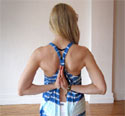 Reverse Prayer (Pashchima Namaskarasana)
Reverse Prayer (Pashchima Namaskarasana)Place your palms together behind you and see how far you can move the hands up your back. Hold and breathe.
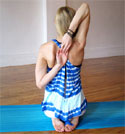 Cow Face Arms (Gomukhasana)
Cow Face Arms (Gomukhasana)Left hand extends back and bends at the elbow, top of the hand against the back. Right hand extends forward, windmilling its way to the top, then to the back, bending by the elbow until the two hands or fingers meet. Clasp. Hold and breathe. Other side.
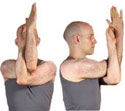 Eagle Arms (Garudasana)
Eagle Arms (Garudasana)Inhale stretching your arms wide to the sides and get them crossed together in front of you, left arm below the right arm. Bend both elbows and see if you can clasp your hands together, fingers interlaced. Inhale and lift your elbows as high up while trying to stretch your arms forward. Feel the front of the shoulders being pulled together. Hold and breathe. Other side.
LYING DOWN
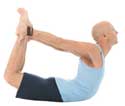 Bow (Dhanurasana)
Bow (Dhanurasana)Lie flat on your mat belly down. Bend your knees and hold on to your ankles. Inhale lift the chest up and try to stretch your legs, pulling the arms, pulling the shoulders back. Hold and breathe. Other side.
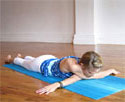 Criss-Cross ()
Criss-Cross ()Lie flat on your mat belly down. Lift your chest up and try to reach out your left arm as far to the right as possible. Right arm over the left, reaches as far left. Inhale lengthen, exhale sink. Hold and breathe. Other side.
 Thread the Needle ()
Thread the Needle ()Get into Child's Pose and lift the pelvis up. With a straight right arm, twist the should with the left arm passing its way under the right arm. Reach as far to the side with the left hand. Hold and breathe. Other side.
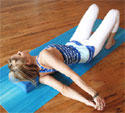 Eight Point Shoulder Opener ()
Eight Point Shoulder Opener ()Lie on your left side, head supported by a block. Clasp your hands behind you and lift the hands up, keeping the arms straight. With the left shoulder on the mat, twist the pelvis to the right so that it rests on the buttocks. Feet flat on the mat with knees bent. Hold and breathe. Other side.
 Elbows on Blocks ()
Elbows on Blocks ()Place two blocks on top of the other in front of your mat. Kneel down with wide knees, toes tucked-in, hands clasped together and rest your elbows on the blocks. Try to sink your chest and your head below your upper arms. The blocks should be in front of the top of your head. Inhale lengthen, and on the exhale, sink your chest down, pulling on the shoulder. Feel the shoulder stretch. Hold and continue breathing.
IV CORE
A strong core is an essential component to a successful handstand. Surprisingly, core is also the key to protecting your wrists. A strong core increases the efficiency of the rotator cuff muscles, which in turn stabilizes the shoulders allowing it to carry more load and lessen the load passed on the wrists.
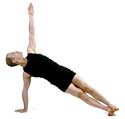 Side Plank (Vasisthasana)
Side Plank (Vasisthasana)(Vinyasa until upper plank): put your full body weight on the left hand and roll-up the side shoulder, right hand reaching up, keeping the body straight and linear. Look at your right hand and breathe. Other side.
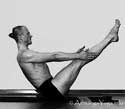 Boat Pose (Navasana)
Boat Pose (Navasana)Vinyasa until Downward Dog, jump through or step through your hands for a seated pose. Bend both your knees and grab behind the thighs, keeping the back straight. Inhale lengthen, and release the legs on the exhale, extending the arms forward, straightening the legs pointed 45 degrees to the corner of the ceiling. Breathe for 5 counts. Cross your legs supporting your body by putting your hands beside you, inhale lengthen, and lift on the exhale. Hold for a few breaths. And release, back into Boat. 3x. From crossed legs, see if you can snap your legs back into plank.
 Locust Pose (Salabhasana)
Locust Pose (Salabhasana)From plank, lower yourself down completely, extending your arms forward. Inhale lengthen, on the exhale, lift your chest, lift your arms, lift your knees and thigh. Breathe. Spread your wings like a jet plane, lifting your chest ever higher. Breathe. Back to Superman or Superwoman...lift...breathe...5...4...3...2...1....Child's Pose everyone. You did well. Finish off with a Vinyasa.
V GETTING INTO A HANDSTAND
There are many ways to get into a handstand. Every handstand guru has his/her own style. Three proven approaches are listed below - the yogic kick (back on the wall), gymnastic handstand press (back on the wall, advanced) and the walking up the wall (front on the wall, advanced):
- Yogic Kick
Kino MacGregor is one of the most iconic figures in Ashtanga Yoga today, having learned from the master himself, Pattabhi Jois. Despite that, it took her 5 years to perfect the handstand.
- Handstand Press
This is the most advanced, used by gymnasts, requiring utmost strength, balance and control. The training for this approach is layered - a training regiment within a training regiments. There is no momentum - no kick. Straight legs far apart, both hands are pressed on the mat shoulder width apart, arms straight, hips as close to the elbows as possible, move the body weight as far forward as you can, shoulders going beyond the wrist line (to establish the fulcrum). You should be feeling you legs are slowly being unweighted until only the tips of the toes are touching the mat. Slowly lift your pelvis up together with your legs until the torso is vertically up - hips, shoulders and wrists are stacked into a straight vertical line. Gently move your legs together.
- Walk to Wall Facing Wall
This is more advanced than the Yogic Kick because when you get tired holding from a Yogic Kick, you can simply bring your legs down. Not so with Walk to Wall. When you get tired on this, you still have to walk your hands forward until you can step down. If you are become too fatigued on the wall, you won't have enough strength to walk your hands and you'll simply have to crash down, hopefully tucking your head so you can roll down.
 Handstand Up and Down Wall Walk ()
Handstand Up and Down Wall Walk ()
Downward Dog with feet near the wall. Slowly walk your feet up the wall as you walk your hands closer to the wall. When vertical, come back and repeat.
VI WALL-SUPPORTED HANDSTAND WITH SECTIONAL FOCUS
There are many elements to a successful handstand and they must all be unified together at the same time to make it work. A weak link in that chain can cause the handstand to fail. Handstand requires full body coordination.
We will all go to the wall and practise our handstands with isolated focus on the elements that we need to engage. We won't stay too long on the handstand so as not to tire-out the little muscles we need to keep our handstand stable.
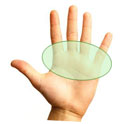 Hand and Finger Focus ()
Hand and Finger Focus ()Fingers should be as spread out as much as possible to widen the base for greater control. The index finger should be pointed forward. The body weight should be centered on the upper palm area where the base of the fingers are. This serves as your fulcrum. If you overbalance, you can push against the fingers to tip you back. If you underbalance, you can push against the palm-base to make the correction. 30 secs.
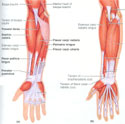 Shoulder and Arm Focus ()
Shoulder and Arm Focus ()Handstand on the wall, so our backs are facing the wall, with fingers about a foot away from the wall (this gives more room for the shoulders to move). Straighten the arms and pull the shoulders back as you push the chest forward - this opens up the shoulders. Focus on the shoulders. 30 secs.
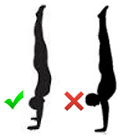 Head Focus ()
Head Focus ()Best to keep the head within your shoulders than to lift it up to look at the floor. The spine follows the curvature of the head. So if the head is pulled out, the spine follows and you end up in a banana shape. Best to tilt the head minimally and just look 'upwards' with the eyes to see the floor - your head is still in and your back remains straight. 30 secs.
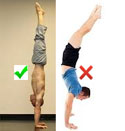 Torso Focus ()
Torso Focus ()Handstand on the wall, so our backs are facing the wall. Focus on the torso and engage the abs, rib cage reaching down to the pelvis as the lower back is straightened. Without this engagement, the legs tend to fall back behind creating a circular curvature on the spine. Breathe and isolate the focus there. 30 secs.
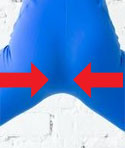 Butt Cheek Focus (Mula Bandha)
Butt Cheek Focus (Mula Bandha)Handstand on the wall, so our backs are facing the wall. Squeeze the butt cheeks and squeeze the anal muscle. This is essentially the Mula Bandha. Play with it, contracting and easing up and contracting. 30 secs.
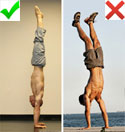 Feet and Legs Focus ()
Feet and Legs Focus ()Handstand on the wall, so our backs are facing the wall. Focus on the feet pointed up. Focus on the legs being straight and together. Engage the feet and the legs into a singularity. 30 seconds.
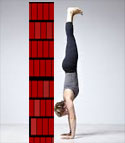 Handstand Integration on a Wall ()
Handstand Integration on a Wall ()Take a full one minute on the wall and integrate all the elements into a unified singularity, being mindful of the feet direction, legs being together and straight, abs engaged straightening the lower back, arms rotated out to open the shoulder, head minimally tilted, etc. It helps to see the full body as one engaged muscle (think of your entire body as one phallic erection!).
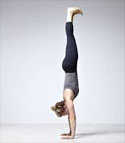 Freestanding Handstand Integration ()
Freestanding Handstand Integration ()Take a full one minute by the wall but not resting on it, and integrate all the elements into a unified singularity. If the feet leans on the wall, tap against it and try to regain balance by using the finger controls. Repeat until too tired to go on. At this point, the finer muscle strands needed for a balanced handstand is already too fatigued to do anything anymore. So we shift into brute force conditioning.
VII HANDSTAND CONDITIONING EXERCISES
This routine was done last because it doesn't require balance - just brute power. Handstand requires the use of minor muscle strands that easily get tired. We want to use these fine muscles for balance and execution for the above - to conserve energy.
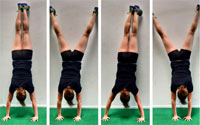 Handstand Traverse Wall Walk ()
Handstand Traverse Wall Walk ()Handstand on the wall facing the wall. Walk the hands along to the other side of the wall and then come back.
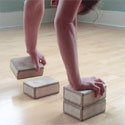 Block Rotation ()
Block Rotation ()With 2 hands on each block, handstand with back facing the wall. Lift the right hand, put it on the floor and lift the left hand and put it on the floor. Now, put the right hand back on the block and do the same thing for the left hand. You will essentially be doing a one-hand push up as you transfer your weight to the other hand on the block. Repeat.
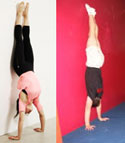 Handstand Hold on a Wall ()
Handstand Hold on a Wall ()Do a wall handstand facing the wall and hold it there for a minute. Release and rest for 30 secs. Repeat and hold for 30 secs. Release and rest for 30 secs. Repeat but do the handstand with the back facing the wall.
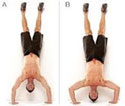 Freestyle Handstand ()
Freestyle Handstand ()Use the remaining time to do your own freestyle practice.
VIII WINDING DOWN
 Corpse Pose (Savasana)
Corpse Pose (Savasana)Lie flat on your mat, feet dangling on its side, palms facing up. Let go of everything. Dissolve. Relax completely.
Class Instruction Ends Here
--- Gigit (TheLoneRider)
YOGA by Gigit ![]() |
Learn English
|
Learn English ![]() |
Travel like a Nomad
|
Travel like a Nomad ![]() |
Donation Bank
|
Donation Bank ![]()
Gallery from Sep 17, 2021 class in Chiang Mai, Thailand
![]() The following people like this:
The following people like this:
Leave a comment?
Reader Comments:
 Rica Hernandez Gomez
Rica Hernandez Gomez(24 August, 2015) Good job Gigit! Can I join?
 Mechel Zapanta
Mechel Zapanta(24 August, 2015) Awesome and interesting blog. Wanna join ur class one day!
 Janet Cang
Janet Cang(24 August, 2015) Making this my homework
Sources:
Yoga Studio Series (studio-type offerings)
Studio-type Yoga classes
Studio-Type Yoga Series
Yoga classes typically offered in Yoga Studios
Practical Yoga Series (for day-to-day life)
Practical Yoga
Practical Yoga
Yoga classes for optimum day-to-day functionalityPranayama Series (breath regulation)
Pranayama Classes
Pranayama Yoga Series
Basic Pranayama Classes (breath regulation)
Intermediate-Advanced Pranayama
Shatkriya Series (purification/cleansing)
Yoga for Cleansing (Shatkriya Purification)
Shatkriya Series
What are Shat Kriyas?
Shat Kriyas are yogic purification practices for cleansing the system. In Hatha Yoga, this is given paramount importance, more importance than Yama and Niyama. They argue that before the body should even begin to practice yoga, the body should be cleansed and purified first. e.g. - before your race your car on a track, you have to ensure the track is clean, obstructed and can take the rigors of a race car. More info here: 6 Shat Kriya
Next story:

![]()
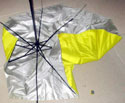
![]()
Re-purposing a Broken Umbrella
(Aug 27, 2015) A broken umbrella is usually thrown away. I use this umbrella as a metaphor to 're-purpose' for creative utility...more »»
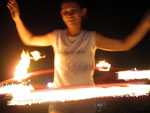
![]()
Yogathering 2
(Oct 3-4, 2015) Yogathering 2 shifts into high gear after the successful pioneering event last August that saw yogis and yoginis gather outside the mat into a chill space out of town for yoga, meditation, healthy eats, music and fun activities...more »»
More on Cebu City:
About Cebu City
- Cebu City is the 2nd biggest city in the Philippine (next to Manila) - and it continues to build and expand. Traffic is getting bad. Decentralization is being developed with the SM Super Mall in the SRP south and the suburban towns in the north.
- Boat from the airport to the city center - even without traffic, it takes about 4 rides to reach the city. But with Cebu's increasing traffic congestion, it has become a nightmare. Instead of taking the land route, take the water route - no traffic, fresher air and cheaper. From the airport, take the yellow multi-cab straight to the river port and take the ferry (there's only one destination) to the city. Take the 02B jeep and get off at UC near Jones - you're now on the city's main artery.
- given its size and increasing congestion, Cebu really needs a mass railway system - something that is conspicuously lacking, but no one seems to complain about
- Cebu is bursting at the seams on the yoga scene. There are about 20 yoga centers in the city - from yoga studios to gyms offering yoga and hotels jumping on the bandwagon
- a trendy and safe place in Cebu where you can chillout for coffee and enjoy good eats would be at the Ayala Mall
- there are other pocket-areas for trendy hangouts - Banila Town Center, Crossroads, Escario Plaza, La Vie, etc.
- the tourist area where most of the budget hotels and restaurants are, are located within the Mango area, although it has a seedy belly feel. Kids may swarm on you pretending to be begging, but they could be picking your pocket or your backpack pockets - be careful
- many pick-pockets in the Colon area - be careful
Cebu City Google Map
 Cebu City, Philippines
Cebu City, Philippines
 Tops - hilltop offering panoramic view of the city
Tops - hilltop offering panoramic view of the city Taoist Temple - temple on a hillslope in Lahug with panoramic view of the city
Taoist Temple - temple on a hillslope in Lahug with panoramic view of the city
 Hostel Seven Cebu - newly opened, resto/bar, central location, solo/group travellers
Hostel Seven Cebu - newly opened, resto/bar, central location, solo/group travellers
Juana Osmeña Street, Cebu City S Hotel & Residences - new hotel, luxury rooms, central location
S Hotel & Residences - new hotel, luxury rooms, central location
827 M. Velez corner Andres Abellana St.
 Fujinoya - new and refreshing twists to Western style desserts using Japanese techniques
Fujinoya - new and refreshing twists to Western style desserts using Japanese techniques
Wilson St., Lahug, Cebu City - tel. 888.6075 Bad Boys Wingz - Buffalo Wings, unique versions of sauces! Great service, accommodating staff, bad boys vibe
Bad Boys Wingz - Buffalo Wings, unique versions of sauces! Great service, accommodating staff, bad boys vibe
Kasambagan, Cebu City | (032) 415 4811
 Love Yoga World - yoga studio
Love Yoga World - yoga studio
11/fl, Skyrise 2 Tower, IT Park, Lahug, Cebu City Yoga Now - first Yoga and Wellness studio in Mactan offering daily Yoga Classes
Yoga Now - first Yoga and Wellness studio in Mactan offering daily Yoga Classes
at The Yacht Club Mactan
 Cebu Mountain Bike Adventure - MTB tours, bike sales and repairs. Bed and Breakfast + Resto Cafe + wifi
Cebu Mountain Bike Adventure - MTB tours, bike sales and repairs. Bed and Breakfast + Resto Cafe + wifi
1298-b V.Rama Ave, Guadalupe, Cebu City | 0942.959.7451
Cebu City to Iloilo City by boat
- Trans Asia Shipping - Terminal 2, Pier 3, 15 hours, Mondays and Fridays, 6 pm (ETA 8:30 am, next day), Trans Asia 19 boat, Tourist P1545 (SR P1236), 2nd Class open air P1400 (SR 1120)
Cebu City to Ormoc by boat
- SUPERCAT - 3 hours, 5:30 am | 9:00 am | 12:30 pm | 4:00 pm
Business Class: Regular 1500, Student 1,200, Senior/PWD 1,071
Tourist (Aircon) & Economy (Non-aircon): Regular 1100, Student 880, Senior/PWD 785 - OCEANJET - 3 hours, 5:00 am | 6:00 am | 9:30 am | 12:00 pm |1:00 pm | 4:30 pm
Open-Air (OA) 1100, Tourist Class (TC) 1100, Business Class (BC) 1600
Cebu City to Bantayan Island
The best and fastest way is by Ceres Bus at the North Bus Terminal, adjacent to SM City. The bus takes 4.5 hours going north until it reaches Hagnaya Port. From there, you pay the ferry company separately. The bus boards the ferry until it reaches Sante Fe Port (1.5 hours) in Bantayan Island. From Santa Fe, the bus goes to Bantayan Poblacion and then to Madridejos.
Ceres Bus - PHP 260 (to Santa Fe), 4.5 hours to Hagnaya Port + 1.5 hours by ferry.
Schedule: according to the dispatcher, trips begin at 6 pm (this arrives Hagnaya around 10:30 pm but the first ferry leaves at 1 am...that's a 2.5-hour wait at the port), leaving every hour until 1 pm the following day (I speculate that 1 pm is the last trip to avoid rush hour traffic along Consolacion). This doesn't match the ferry schedule so the bus simply waits until a ferry departs. e.g. the 6 pm trip arrives 10:30 pm and waits for the 1 am ferry. The last trip, 1 pm, arrives 5:30 pm, in time for the ferry's last trip.
Bus arrives at terminal 30 mins before departure. Luggages are P150/pc if no passenger.
Alternatively, you can get off the bus at Hagnaya Port and take the ferry independently. There are 2 ferry companies:
Super Shuttle Ferry
PHP 359 + 25 Terminal fee, 1.5 hours
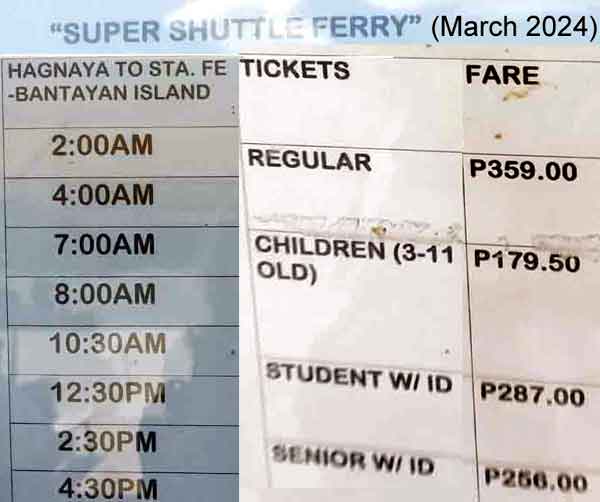
Island Shipping
PHP 350 + 25 Terminal fee, 1.5 hours

Cebu City to Dumaguete
Cebu City to Dumaguete by Boat
- George and Peter Lines - Mon/Thur/Sat/Sun 10pm, (035)225.4337, 0922.557.1023
- Oceanjet - via Tagbilaran, daily 6am, dumticketing@oceanjet.net, 0918.898.2188
- Cokaliong - Mon/Tue/Wed/Thur/Fri/Sat 7pm, Sun 12pm, 6 hours, (035)225.3599
Cebu City to Dumaguete via Liloan (bus, boat, jeep, tricycle)
- Cebu City South Terminal - take the southbound Ceres bus to Liloan, P200, 5 hours
- Liloan - the bus drops you off at the Liloan Port where you board the Fastcraft to Sibulan, Negros Oriental, P62, 30 mins
- Sibulan - at the Sibulan Port, the jeeps wait for Fastcraft passengers to take them to the public market in Dumaguete, P12, 30 mins.
- Public Market - at the market, you can take any tricycle to your hotel, P8 for short trips
Cebu City to Tagbilaran, Bohol
Cebu City to Tagbilaran, Bohol
- Trans Asia Shipping - (updated Jan 25, 2025) Terminal 2, Pier 3, 4 hours, Mondays, 12nn (ETA 4 pm), Trans Asia 3 boat, 2nd Class open air P370 (SR 296)
- Lite Ferries - (updated Jan 25, 2025) Pier 1 Terminal 1, 4 hours, departs daily 1:00pm and 10:00pm, Sundays only 10:00pm
Standard (Lying) Php 370, Tourist (Lying Aircon) Php 520
Address: 1022 Mj Cuenco, Cebu City, 6000 Cebu
Email Address: info@liteferries.com.ph
Mobile Number: +639778225483 / +639989995483
Telephone: (032) 255-1721 to 23, 25, 26 /(032) 349-7349
-------------------
- Weesam Express - Pier 4, departs 9:00 AM, 2:00 PM, 6:30 PM, 2 hours
one way: Economy (aircon) P500.00, Economy (non-aircon) P400.00, First Class P600.00
round trip promo (at least 2 days advance booking): Economy (aircon) P600, Economy(non-aircon) P500, First Class P1200
round trip promo (1 day or on the day booking): Economy (aircon) P800, Economy (non-aircon) P700, First Class P1200 - Ocean Jet - Pier 1, departs 6-7-8-9:20-10:40-11:40AM, 1-2-4:20-6:35PM, 2 hours
Open Air / Tourist Class P800, Business Class P1000
+63 932 8734 885 / +63 922 8572 300 - SuperCat (2GO) - Pier 1, departs 08:15-13:30-15:10-18:00-19:40
P 500.00
+63 32 233 7000
Cebu City to Siquijor by Boat, via Tagbilaran
Cebu City to Siquijor, via Tagbilaran
- Lite Ferries - Pier 1, departs M/W/SAT at 1:00pm, 10 hours, economy Php 649 (through barkota.com), layover in Tagbilaran 5:45pm-8:00pm, arrives Larena Port, Siquijor at 11:00pm
+63 977.822.5483 / +63 998.999.5483 / +63 925.347.5483 / (032)255-1721 to 26 / (032)414-9001 to 03
info@liteferries.com / www.liteferry.com - Ocean Jet - Pier 1, departs daily at 1pm, 5 hours
Open Air P1600
+63 932 8734 885 / +63 922 8572 300
Cebu City to Siquijor by Bus, via Liloan (Santander)
(as of Jan 2023)Sugbo Urban
There is only one bus plying this route - Sugbo Urban. Tourist class coach, a/c, comfortable, Sun-Fri (these dates keep changing). P420 for bus, P275 for ferry to Liloan. Leaves Cebu City (South Bus Terminal) at 8 pm (Sundays 1 am), heads south to Liloan (Santander), takes the ferry to Larena Port, Siquijor, docks around 5 am, makes a clockwise roundtrip around Siquijor Island - Larena, Enrique Villanueva, Maria, Lazi (stops at Lazi market for breakfast and leaves 6:50 am), San Juan, Siquijor (arrives 8am, P50 from Lazi to Siquijor Poblacion) and catches the 1pm ferry at Larena Port for Liloan, Cebu and resumes its land route. Arrives Cebu City 10 pm.
Sugbo Urban is the cheapest and most convenient way because when it reaches Larena Port (Siquijor), it continues its trip around the island (clockwise) along the circumferential road, passing through - Enrique Villanueva, Maria, Lazi, San Juan, Siquijor...and back to Larena. It spares you the cost of hiring a tricycle or habal-habal which charges exhorbitant fares. Besides, it's a long trip to the other side of the island to be taking by tricycle.
This is also the slowest. The bus arrives Liloan Port around 12:30 am but the ferry leaves 2:30 am (2 hours of waiting time). The ferry trip is a slow 4 hours (this should only take 1.5 hours with Montenegro or Alesson), arriving Larena around 6:30 am. This 4 hour voyage offers no comfortable sleeping - you stay upright on your seat or sleep on the floor on a cardboard. The boat waiting/voyage takes 6 hours. Altogether, the entire trip takes 11.5 hours until the bus reaches Lazi.
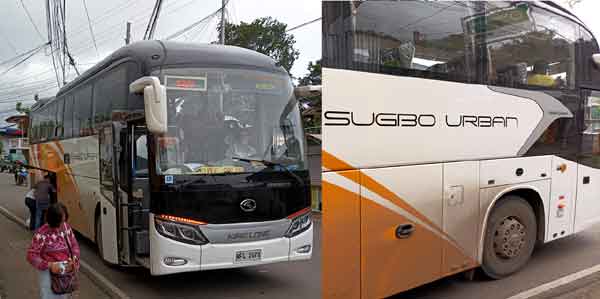

Cebu City to Camotes Island
Cebu City to Camotes Islands
- via Poro - from Pier One in Cebu City, take the Ocean Jet for Poro, 2 hours, daily trip - 6am and 3pm (0936.823.8762 |0956.270.6610 | 0999.889.9999).
- via Consuelo - from Cebu City, take the northbound bus passing through Danao and get off at the Danao Port. At the Port, take a Jomalia Shipping boat for Consuelo (San Francisco, Camotes), P220/pax, a/c, 2 hours, daily trip - 5:30am, 7:00am (special trip), 8:30am, 12:00 noon (express), 2:30pm, 5:30pm and 9:00pm (express, Fri/Sat/Sun only).
Camotes Islands to Cebu City
- Poro - Cebu City (fastest and most direct) - go to Poro and take the 8am or 5pm Ocean Jet to Pier One in Cebu City, P380/pax/aircon, 2 hours
- Consuelo - Danao - Cebu City - go to Consuelo (San Francisco) and take the Jomalia Shipping boat to Danao, P220/pax, a/c, 2 hours, daily trip - 5:30am, 7:00am (special trip), 8:30am, 12:00 noon (express), 2:30pm, 5:30pm and 9:00pm (express, Fri/Sat/Sun only). From Danao, take the Ceres Bus to Cebu City
Blogs
Cebu City
CEBU CITY2025
2024
2022
2017
2015
2014
2013
2012
More on Cebu Province:
Suggested Destinations in Cebu
- Camotes Islands - caves, beaches
- Cebu City - rich in culture and history, 2nd largest city in the Philippines
- Moalboal - amazing coral reef system, sardine bowl, deep drop-off for freediving
- Oslob - Butanding (whale shark) watching
- Bantayan Island - long stretch of fine white sand beach, Virgin Island for snorkeling
- Malapascua Island - divers' paradise for seeing the rare Thresher Shark
- Cantabaco Cave - Toledo
- Barile Waterfalls - Barile
- Whale Shark Tour - Oslob
- Carcar - chicharon and lechon in public market
Currency Converter
»» back to Yoga
»» back to Homepage
ARCHIVE 2025:
JAN |
FEB |
MAR
1970 |
1973 |
1975 |
1976 |
1977 |
1979 |
1981 |
1996 |
2000 |
2001 |
2002 |
2003 |
2004 |
2005 |
2006 |
2007 |
2008 |
2009 |
2010 |
2011 |
2012 |
2013 |
2014 |
2015 |
2016 |
2017 |
2018 |
2019 |
2020 |
2021 |
2022 |
2023 |
2024 |
2025 |
ALL BLOGS


